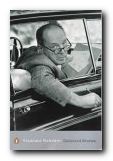a critical examination of Nabokov’s collected stories
 His next story, ‘The Return of Chorb’ (October 1925), was written just after the completion of his first novel Mary, and is therefore possibly influenced by the more complex structures of the novel form. Nabokov turns again to the theme of grief and loss, and he combines it with his ever-recurrent topics of death and recapturing the past. But he also introduces for the first time an element of grotesqueness and dramatic irony which were later to become hallmarks of his mature style.
His next story, ‘The Return of Chorb’ (October 1925), was written just after the completion of his first novel Mary, and is therefore possibly influenced by the more complex structures of the novel form. Nabokov turns again to the theme of grief and loss, and he combines it with his ever-recurrent topics of death and recapturing the past. But he also introduces for the first time an element of grotesqueness and dramatic irony which were later to become hallmarks of his mature style.
What makes the story especially interesting is the skillful manner in which the sequence of events is rearranged in order to maximise the dramatic irony of the narrative – only to have the climax towards which all the events are pointing denied us.
The story begins with a German burger Herr Keller and his wife returning from the opera to discover that their son-in-law Chorb, a Russian litterateur of whom they disapprove, has come back from honeymoon with news that their daughter is ill. We then learn in flashback that she has in fact been electrocuted whilst on holiday in the south of France, and that Chorb has retraced their journey consumed by grief in his attempt to keep alive the image of his wife (whose name we never know). We also learn that his love for her was of a tender, almost chaste character, and that she was very happy on their honeymoon – which throws her father’s disapproval of Chorb into a critical light.
Back in the narrative ‘present’, Chorb books into a seedy hotel and we learn that he occupies the same room as that to which he had ‘escaped’ from the Kellers’ oppressive fuss on his wedding night. His intention is to mentally re-live their recent experiences so as to fix the image of his dead wife in his mind forever: ‘All there remained was but a single night to be spent in that first chamber of their marriage, and by tomorrow the test would be passed and her image made perfect’ (DS,p.66). He hires a prostitute just for company and goes to sleep as soon as they return to the room.
Whilst he is sleeping, the prostitute looks out of a window onto the opera house where crowds are emerging from the evening’s performance of Parsifal. This is of course the opera the Kellers have been to see. This is a wonderfully constructed moment which brings together all the dramatic ironies of narrative past and present.
We already know about Keller’s irate response to Chorb’s news. We also know from what he has told the Keller’s maid that he can be traced, and that he has compromised himself, albeit with a pure enough motive. Even some of the minor details of the story reinforce the irony here. Not only has Chorb been in the room before, but so has the prostitute. She like him recognises it from the picture of a pink baigneuse above the bed.
Chorb wakes with a terrible shock in the middle of the night, but realises that his ordeal is over. At that moment the Kellers arrive, to discover the prostitute just leaving. And Nabokov, with a very mature sense of restraint, ends the story at that point. Having created all the conditions for a dramatic finale, he witholds the events of the climax, leaving readers to effect the story’s closure in their own minds.
For the point of the story is not merely to arrange a dramatic confrontation: it is to present contrasting sensibilities – the bourgeois and the aesthetic. The artist figure is misunderstood in the narrative, but Nabokov is inviting readers to empathise outside it.
© Roy Johnson 2005
![]() Vladimir Nabokov: The Collected Stories – Amazon UK
Vladimir Nabokov: The Collected Stories – Amazon UK
![]() Vladimir Nabokov: The Collected Stories – Amazon US
Vladimir Nabokov: The Collected Stories – Amazon US
Vladimir Nabokov web links
Vladimir Nabokov greatest works
Vladimir Nabokov criticism
Vladimir Nabokov life and works